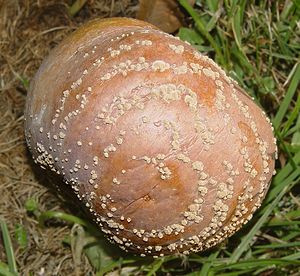Monilinia
| Monilinia | ||||||||||||
|---|---|---|---|---|---|---|---|---|---|---|---|---|

An apple with conidia from Monilia sp. ("Fruit mummy") |
||||||||||||
| Systematics | ||||||||||||
|
||||||||||||
| Scientific name | ||||||||||||
| Monilinia | ||||||||||||
| Honey |
Monilinia , better known by the name of its minor crop form Monilia , is a genus of fungi thatincludesimportant pests of plants in fruit trees . The disease occurs as fruit rot and / or tip drought immediately after flowering. The main pathogens in apples and cherries are the species Monilia laxa , Monilia fructigena and Monilia fructicola . This does not include Monilia albicans , the former name of Candida albicans .
features
The fungus forms many individual conidia carriers on the affected tissue , on which chains of conidia form, which together form whitish to brownish fungal lawns. The typical ring-shaped secondary fruit bodies are easily recognizable, at least in apples. Lawns of conidia are found on dead, undeveloped fruits, dead shoots or petioles. The ripe conidia are lemon-shaped. The species attack fleshy fruits of the rose and heather plants . They rarely form apothecia .
Diseases
Monilinia species cause various diseases. The economically most important are moniliosis / fruit rot or peak drought. Monilinia fructigena forms the typical concentric circles with yellowish pustules in the secondary fruit form and is found mainly on the fruits, Monilinia laxa and also Monilinia fructicola , on the other hand, form grayish pustules that are not concentrically arranged.
Fruit rot
Monilia, especially Monilinia fructigena , only affects injured fruits. It can often be observed that the putrefaction begins at places where it has been eaten or other wounds. The fungus grows through the fruit and leads to total rot. White fruiting bodies of the fungus on the roughly milk-coffee-brown, rotten fruit are typical. The spots are arranged in very characteristic concentric circles.
Infested fruits dry up, remain on the tree or fall off. Completely rotten fruits that have remained on the tree are called "fruit mummies". In order to prevent the pathogen from being transmitted again, infected fruits should be removed from the tree, branches cut back to the healthy wood and this waste destroyed (burned or buried).
The pathogen overwinters in the rotten fruits on the tree, in flowers, in infected branches on the tree or on the ground.
Peak drought
The so-called Monilia peak drought can also occur in the fruit trees mentioned . More Monilinia laxa can be seen on leaves. In wet weather, the pathogen penetrates the plant via the flowers and causes the tip of the shoot to die off. Every now and then, a so-called rubber flow occurs at the transition point between infected and healthy wood .
To stop the disease, infected shoots must be cut back up to 15 cm into the healthy wood and the wounds must be sealed with tree wax if possible.
Infested species
Almost all cultivated fruits, but also some ornamental plants, are affected by the Monilia infestation. In addition to apple , pear , sweet and sour cherry (here especially the morello cherries ) and plum trees , Monilia also occurs in the corresponding ornamental species and almond trees . In the meantime, varieties that are resistant to the fungus are also being bred. Species that Holst-Jensen and Schumacher temporarily placed in the genus Franquinia grow on various heather plants .
Systematics
The mycologist Honey separated the genus Monilinia from Sclerotinia . He divided them into two sections, the Disjunctoriae, which have intercalating disjunctors in the chains of conidia, and the Junctoriae, which lack these. Batra (1991) counted about 30 species worldwide. Holst-Jensen et al. (1997a) determined the polyphyletic position and separated the Disjunktoriae from Monilinia and formed the new genus Franquinia , which has not yet been recognized. Monilinia species therefore only contain the Junctoriae section, which attack the fleshy fruits of the rose family and rarely form apothecia.
species
The list includes all species according to the Fungorum Index, including the unofficial genus Franquinia:
- Monilinia alpina
- Monilinia amelanchieris
- Monilinia ariae
- Monilinia aroniae
- Monilinia aucupariae
- Monilinia azaleae
- Monilinia baccarum
- Monilinia cassiopes
- Monilinia corni
- Monilinia cydoniae
- Monilinia demissa
- Monilinia emarginata
- Monilinia empetri
- Monilinia fructicola
- Monilinia fructigena
- Monilinia gaylussaciae
- Monilinia gregaria
- Monilinia jezoensis
- Monilinia johnsonii
- Monilinia kusanoi
- Monilinia laxa
- Monilinia ledi
- Monilinia linhartiana
- Monilinia mali
- Monilinia megalospora
- Monilinia mespili
- Monilinia mume
- Monilinia olympia
- Monilinia oxycocci
- Monilinia padi
- Monilinia rhododendri
- Monilinia seaveri
- Monilinia ssiori
- Monilinia urnula
- Monilinia vaccinii
- Monilinia vaccinii-corymbosi
swell
- Holst-Jensen, A., LM Kohn, KS Jakobsen & T. Schumacher 1997a. Molecular phylogeny and evolution of Monilinia (Sclerotiniaceae) based on coding and noncoding rDNA sequences. Amer. J. Bot. 84: 686-701.
- Holst-Jensen, A., LM Kohn & T. Schumacher 1997b. Nuclear rDNA phylogeny of the Sclerotiniaceae. Mycologia 89: 885-899.
Web links
- [1] (PDF; 416 kB)
- Forest pests TU Munich: Monilia
- Synoptic keys to the inoperculate stromatic discomycetes in the Nordic countries Sclerotiniaceae & Rutstroemiaceae: Monilinia
Individual evidence
- ^ Synoptic keys to the inoperculate stromatic discomycetes in the Nordic countries Sclerotiniaceae & Rutstroemiaceae: Monilinia
- ↑ http://www.bio.uio.no/bot/ascomycetes/Taxa/Franquinia.html Holst-Jensen & T. Schumacher ined .: The genus Franquinia.
- ↑ http://www.indexfungorum.org/Names/Names.asp Index Fungorum



